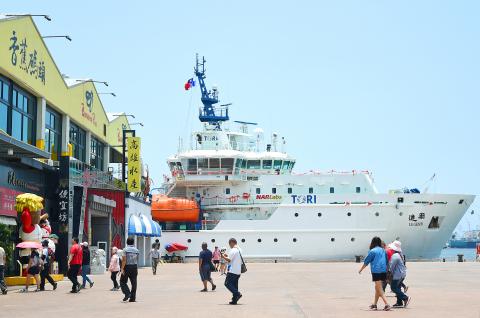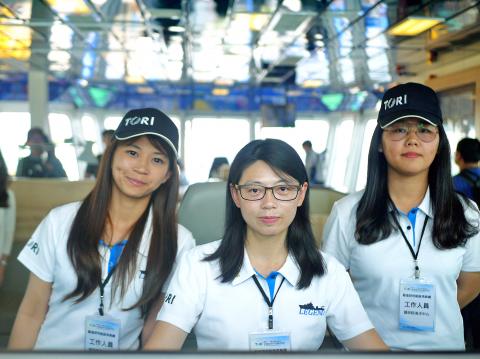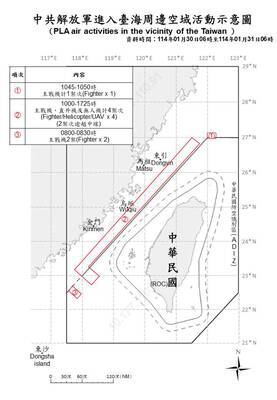The nation’s fifth and largest ocean research vessel, Legend, was yesterday inaugurated at Kaohsiung’s Banana Pier (香蕉碼頭) by the Ministry of Science and Technology.
The 2,629-tonne vessel has a top speed of 12 knots and can accommodate 19 crew members and 24 researchers for 30 days at sea, the ministry said.
The vessel is equipped with a remotely operated underwater vehicle and a giant piston coring system, among other equipment, it added.

Photo: Chang Chung-yi, Taipei Times
Legend is tasked with collecting information about oceanic geography, sampling marine sediment and exploring energy sources in the waters surrounding the nation, the ministry said.
The vessel is docked at Kaohsiung Wharf (高雄港) and is expected to embark on its first official mission in September, Minister of Science and Technology Chen Liang-gee (陳良基) said.
The ministry has not yet decided on its first scientific project, but is seeking to collaborate with neighboring nations for research topics, Chen added.

Photo: Chien Hui-ju, Taipei Times
The ship has three female crew members, including its captain, Huang Chiu-hsing (黃久倖), 37, who graduated from National Taiwan Ocean University and has worked in the industry for a decade.
“It is a pleasure to serve as the nation’s first female captain of an ocean research vessel,” Huang said, adding that her most challenging task would be to familiarize herself with the ship’s twin azimuth thruster propulsion system.
Asked if it would be stressful to manage male crew members, Huang said it is not a problem for her.
The vessel was built by Triyards Marine Services, a Singaporean company, at its Vietnamese shipyard at a cost of NT$880 million (US$29.37 million at the current exchange rate). It arrived at Tainan’s Anping Port (安平港) on Jan. 18, although it was originally scheduled to arrive in October last year, Taiwan Oceanic Research Institute director Wang Chau-chang (王兆璋) said.
The delay was due to a financial crisis at the shipbuilder, which was exposed in June last year, he said.
The vessel’s ownership was transferred from the shipbuilder to the institute on March 31, and the administrative paperwork was finished on Friday last week, he said.
While most of the ship’s devices were purchased from foreign manufacturers, it has two ocean-bottom seismometers jointly developed by the institute and National Sun Yat-sen University’s Institute of Undersea Technology, Wang said.
The university’s institute, which is committed to developing underwater devices, is working to build a deep-diving crewed submersible in five years, its director, Chen Hsin-hung (陳信宏), said, but added that some technical difficulties still need to be overcome.

Taiwanese actress Barbie Hsu (徐熙媛) has died of pneumonia at the age of 48 while on a trip to Japan, where she contracted influenza during the Lunar New Year holiday, her sister confirmed today through an agent. "Our whole family came to Japan for a trip, and my dearest and most kindhearted sister Barbie Hsu died of influenza-induced pneumonia and unfortunately left us," Hsu's sister and talk show hostess Dee Hsu (徐熙娣) said. "I was grateful to be her sister in this life and that we got to care for and spend time with each other. I will always be grateful to

REMINDER: Of the 6.78 million doses of flu vaccine Taiwan purchased for this flu season, about 200,000 are still available, an official said, following Big S’ death As news broke of the death of Taiwanese actress and singer Barbie Hsu (徐熙媛), also known as Big S (大S), from severe flu complications, the Centers for Disease Control (CDC) and doctors yesterday urged people at high risk to get vaccinated and be alert to signs of severe illness. Hsu’s family yesterday confirmed that the actress died on a family holiday in Japan due to pneumonia during the Lunar New Year holiday. CDC Deputy Director-General Tseng Shu-hui (曾淑慧) told an impromptu news conference that hospital visits for flu-like illnesses from Jan. 19 to Jan. 25 reached 162,352 — the highest

TAIWAN DEFENSE: The initiative would involve integrating various systems in a fast-paced manner through the use of common software to obstruct a Chinese invasion The first tranche of the US Navy’s “Replicator” initiative aimed at obstructing a Chinese invasion of Taiwan would be ready by August, a US Naval Institute (USNI) News report on Tuesday said. The initiative is part of a larger defense strategy for Taiwan, and would involve launching thousands of uncrewed submarines, surface vessels and aerial vehicles around Taiwan to buy the nation and its partners time to assemble a response. The plan was first made public by the Washington Post in June last year, when it cited comments by US Indo-Pacific Commander Admiral Samuel Paparo on the sidelines of the Shangri-La Dialogue

Suspected Chinese spies posing as Taiwanese tourists have been arrested for allegedly taking photographs of Philippine Coast Guard ships, local media reported. The suspected spies stayed at a resort in Palawan, where from a secluded location they used their phones to record coast guard ships entering and leaving a base, Philippine TV network GMA said on Wednesday. Palawan is near the Spratly Islands (Nansha Islands, 南沙群島) and other disputed areas of the South China Sea, where tensions have been on the rise between China and the Philippines. The suspects allegedly also used drones without permission and installed cameras on coconut trees in the